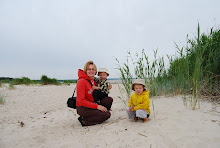In general I do not bake very often during summer because the hot weathers and the hot oven do not match at all. And I am plain lazy for baking during summer. Still, I use to bake for my birthday and also, summer is not summer without a blueberry cake. To make your mouth full of water I share some photos here of the cakes I baked during the latest days (and by now nothing is left;)). But to not be too evil I share the recipes, so you can bake them as well:)
Blueberry cake (
Mustikakook)
The one I have baked at least once in summer during the latest 5 years or so. Blueberries grow in the forest right behind our house, so I do not need to go far to pick them. At least now, because they plan to build houses there and who knows if I can go there to pick blueberries next summer...
2 eggs
1 1/2 dl sugar
2 teaspoons vanilla sugar
100g butter
1 1/2 dl fresh or frozen blueberries
2 dl flour
1 teaspoon baking powder
Mix eggs and sugars. Add melted (and cooled down) butter and flour-baking powder mix. Stir in carefully the blueberries to not smash them. Pour the dough on the round-shaped cake form that is buttered and scattered with some flour. Bake at 175C for about 50 minutes (but my experience says it is ready earlier). It tastes the best with some vanilla icecream!

Dough:
225 g butter
1 dl sugar
5 dl flour
1/2 teaspoon salt
1/2 teaspoon soda
1/2 teaspoon baking powder
1 teaspoon vanilla sugar
2 dl coconut flakes
Filling:
1 kg cottage cheese
250 g sour cream
4 eggs
2 1/2 dl sugar
1 teaspoon vanilla sugar
400 g raspberries
Mix flour, salt, soda, baking powder, vanilla sugar and coconut flakes. Twiddle in butter and sugar. For filling mix all the ingredients but raspberries. Put 3/4 of the dough on big baking pan/plate, pour on the filling and put on the raspberries. Twiddle on rest of the dough. Bake at 200C for 30 minutes.
Halvah-biscuit cake (Halvaa-küpsisetort)It seems to be already a must on my every birthday (at least during the latest years). It is an easy cake because it does not need baking and I like the red currants in it that gives some sour taste into this otherwise very sweet cake.
Note: I am not sure halvah is available in all countries. And the biscuits we use here for biscuit cakes may be rather "exotic" in other countries as well (they have to be hard). But then you have to come here to shop for them;)
3 packages (´a 180 g) biscuits
200 g halvah
200 g butter
250 g sour cream
1 lemon's juice
2 dl red currants
Smash the biscuits and halvah. Melt butter, add sour cream and juice of lemon to it, mix it and add to biscuits. Mix and add the red currants. Mix carefully (to not smash the berries). Pour it to the bowl or cake form that is covered with foil. Put in the fridge at least for 5 hours.
Kama tiramisuThis is
very much Estonian version of the popular Italian dessert. This is so much Estonian that I even cannot find the translation to "kama" into English. My dictionary says: "a mixture of rye-, oat-, barley- and peasemeal" that means if you are not from Estonia you have to come here to shop it:D
Basic:
400 g cream of cottage cheese
2 dl powdered sugar
1 teaspoon vanilla sugar
1 dl kama
4 dl whipped cream
Between: 150 g biscuits (for Estonians, küpsis "Keelekesed")
sea buckthorn berries (astelpajumarju)
For permeating: coffee
Mix all the basic's ingredients. Put 1/4 of the basic into the bowl, then permeate the biscuits and put them on the basic, put on some sea buckthorn berries, then the basic again etc. The upperst layer has to be of the basic. Decorate with some biscuit crumbs and the berries. Put into the fridge for at least 6 hours.




